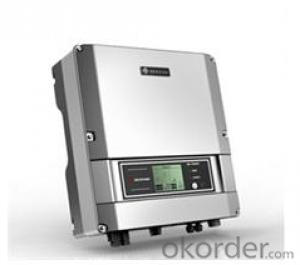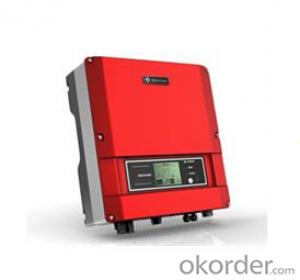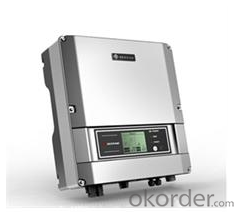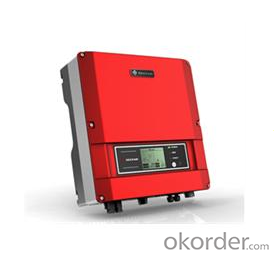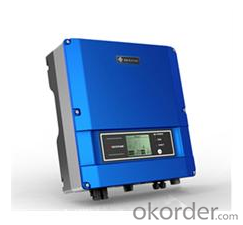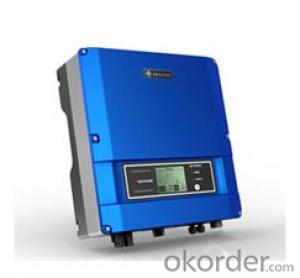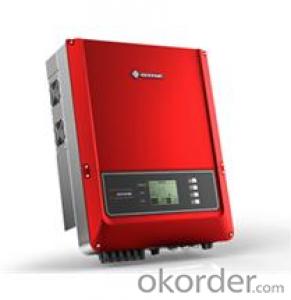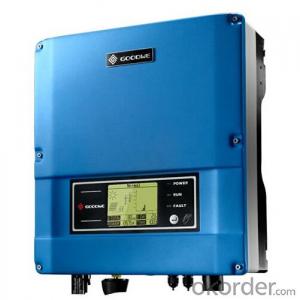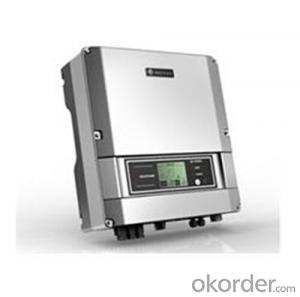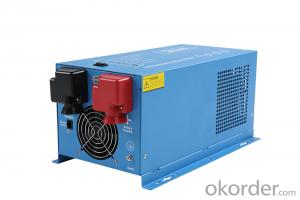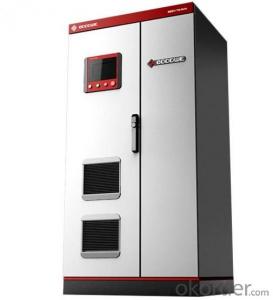20kVA On Grid Solar Inverter GS2000-SS
- Loading Port:
- Shanghai
- Payment Terms:
- TT OR LC
- Min Order Qty:
- 10 unit
- Supply Capability:
- 100 unit/month
OKorder Service Pledge
OKorder Financial Service
You Might Also Like
GW2000-SS
GW2000-SS photovoltaic inverter is suitable for home rooftop photovoltaic system, designed under modern industrial concept. There are three colors for option with fashionable appearance. This model uses state-of-the-art control technology, which has an extremely powerful input voltage and input current capability. The THDi can be controlled within 1%, when the maximum output power of PV system ranges from1800W to 2300W. It holds a safe lead among similar products.
| Input Data | Max.PV-generator power[W] | 2300 |
| Max.DC voltage[V] | 500 | |
| MPPT voltage range[V] | 125~450 | |
| Turn on DC voltage[V] | 125 | |
Max.DC work current[A] | 15 | |
| Number of inputs/MPP trackers | 2/1 | |
| DC connection | MC IV connector | |
| Self-energy consumption[W] | <5< td=""> | |
| AC Output Data | Nominal AC power[W] | 2000 |
| Max.AC power[W] | 2000 | |
| Max.output current[A] | 10 | |
| Nominal output voltage range | According to VDE 0126-1-1/AI, RD1663, ENEL, G83,G59,SAA | |
| AC grid frequency | According to VDE 0126-1-1/AI, RD1663, ENEL, G83,G59,SAA | |
| THDi | 〈1% | |
| Power factor | ~1 (Norminal power) | |
| AC connection | Single phase | |
| Efficiency | Max.efficiency | 97.0% |
| European efficiency | 96.0% | |
| MPPT adaptation efficiency | >99.5% | |
| Safty Equipment | Leakage current monitoring unit | Integrated |
| DC switch disconnector | Optional | |
| Islanding protection | AFD | |
| Grid monitoring | According to VDE 0126-1-1/AI,AS4777.1/2/3, RD1663, ENEL,G83,G59-2 | |
| Normative Reference | EMC compliance | EN 61000-6-1,EN 61000-6-2, EN 61000-6-3,EN 61000-6-4 |
| Safety compliance | According to IEC 62109-1,AS3100 | |
| General Data | Dimensions(W*H*D) [mm] | 330*350*125 |
| Net weight [kg] | 12 | |
| Housing | For outdoor and indoor | |
| Mounting information | Wall mounting | |
| Operating temperature range | -20~60℃(up 45℃ derating) | |
| Relative humidity | 0 ~ 95% | |
| Site altitude[m] | 2000 | |
| IP proection class | IP65 | |
| Topology | Transformerless | |
| Cooling | Nature convection | |
| Noise level[dB] | 〈25 | |
| Display | 4"LCD | |
| Communication | USB2.0;RS485(Wireless/Bluetooth optional) | |
| Standard warranty[years] | 5/10(optional) |
- Q: Can a solar inverter be used with different AC voltage systems?
- No, a solar inverter cannot be used with different AC voltage systems. It is designed to convert the DC power generated by solar panels into a specific AC voltage that is compatible with the electrical grid. Using it with a different AC voltage system could lead to compatibility issues and may damage the inverter or the electrical system.
- Q: Can a solar inverter be used with multiple solar arrays?
- Yes, a solar inverter can be used with multiple solar arrays. In fact, many solar installations utilize multiple solar arrays to increase the overall power output. The solar inverter converts the DC power generated by the solar arrays into AC power that can be used in homes or fed back into the grid. It is designed to handle the combined power output from multiple solar arrays, allowing for efficient utilization of solar energy.
- Q: Can a solar inverter be used in a solar-powered air conditioning system?
- Yes, a solar inverter can be used in a solar-powered air conditioning system. A solar inverter is responsible for converting the direct current (DC) generated by solar panels into alternating current (AC) that is compatible with the electrical requirements of air conditioning systems. By using a solar inverter, the solar energy captured by the panels can be efficiently used to power the air conditioning system, making it a sustainable and eco-friendly solution.
- Q: How do you monitor the performance of a solar inverter?
- To monitor the performance of a solar inverter, several methods can be employed. Firstly, real-time monitoring of key parameters such as voltage, current, and power output can be done using specialized monitoring devices or software. These tools provide a comprehensive overview of the inverter's performance, allowing for immediate identification of any issues or deviations from expected performance. Additionally, regular inspection and maintenance checks are crucial for performance monitoring. This involves visually inspecting the inverter for any physical damage or abnormalities, as well as checking the connections and wiring. Any signs of wear or malfunction should be promptly addressed to ensure optimal performance. Furthermore, data logging and analysis play a vital role in monitoring the inverter's performance over time. By collecting and analyzing historical data, trends and patterns can be identified, helping to detect potential issues or performance degradation. This can be done using software platforms that track and analyze the data from the inverter. Overall, a combination of real-time monitoring, regular inspections, and data analysis allows for effective performance monitoring of solar inverters, ensuring their optimal functioning and addressing any performance issues promptly.
- Q: What are the signs of a faulty solar inverter?
- Some signs of a faulty solar inverter include a sudden decrease in energy production, frequent system shutdowns or restarts, unusual noises coming from the inverter, error messages or warning lights displayed on the inverter, and a lack of communication between the inverter and monitoring devices.
- Q: How does a solar inverter protect against short circuits?
- A solar inverter protects against short circuits by monitoring the electrical current flow and detecting any abnormal increase in current caused by a short circuit. Once a short circuit is detected, the inverter immediately shuts down the power output to prevent any damage to the solar panels, the inverter itself, or the electrical system.
- Q: Can a solar inverter be used in locations with high humidity or extreme temperatures?
- Yes, solar inverters are designed to withstand high humidity and extreme temperatures. They are built with robust materials and protective coatings to ensure reliable operation in various environmental conditions. Additionally, many solar inverters undergo extensive testing and are certified to meet industry standards for performance and durability in challenging climates.
- Q: What is the lifespan of a solar inverter?
- The lifespan of a solar inverter typically ranges from 10 to 20 years, depending on various factors such as the quality of the inverter, usage patterns, maintenance, and environmental conditions.
- Q: How does a three-phase solar inverter differ from a single-phase inverter?
- A three-phase solar inverter differs from a single-phase inverter in terms of the number of phases they support. While a single-phase inverter is designed to work with a single-phase electrical system, a three-phase solar inverter is specifically designed to handle three-phase electrical systems. This means that a three-phase inverter can handle higher power loads and is more efficient in distributing power across the three phases, resulting in better overall performance and stability for three-phase electrical systems.
- Q: Can a solar inverter be used with a solar-powered electric vehicle charging station?
- Yes, a solar inverter can be used with a solar-powered electric vehicle charging station. The solar inverter is responsible for converting the direct current (DC) electricity generated by the solar panels into alternating current (AC) electricity that can be used to charge electric vehicles. This allows the solar-powered charging station to efficiently utilize the solar energy and provide clean and sustainable charging for electric vehicles.
Send your message to us
20kVA On Grid Solar Inverter GS2000-SS
- Loading Port:
- Shanghai
- Payment Terms:
- TT OR LC
- Min Order Qty:
- 10 unit
- Supply Capability:
- 100 unit/month
OKorder Service Pledge
OKorder Financial Service
Similar products
Hot products
Hot Searches
Related keywords
